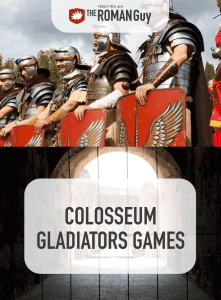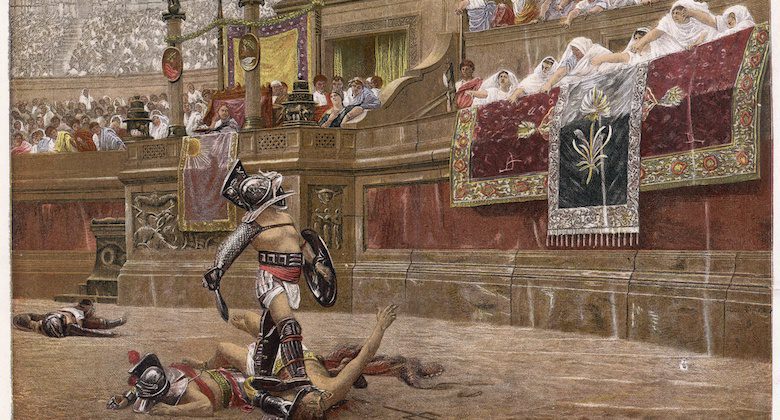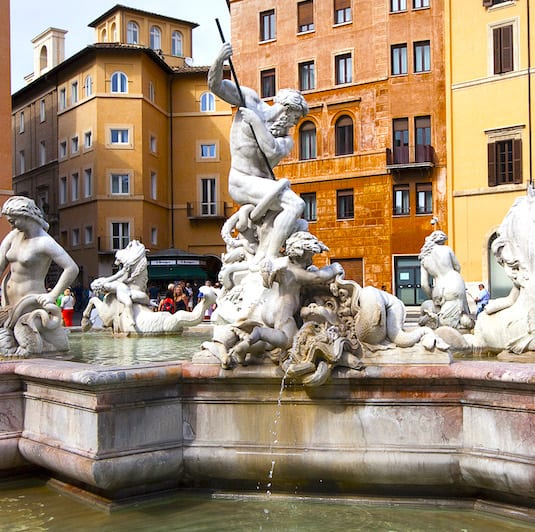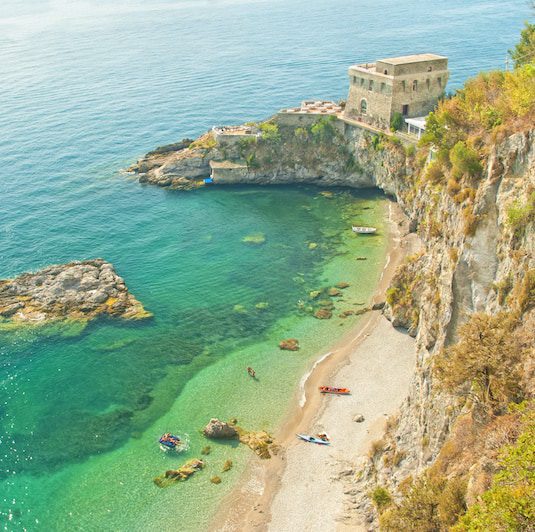Planning a trip to Rome and want to learn about the real Colosseum facts? Some say the stories and tales about the Colosseum are unbelievable and we’d tend to agree. That said, most are true. The building might as well have been painted red, but lets run through the facts and myths. What was the Colosseum actually used for?
Pro Tips:
- Bookmark this page so you can easily find it later.
- Check out our guided Colosseum tours for the best experiences.
Colosseum Myths and Facts
Brutal power struggles in ancient Rome, epic battles and political intrigue-––what’s not to love about Gladiator II?
I’m a huge fan of a good action-packed movie based on historical events. But let’s be honest, I can’t help but dive into all the historical inaccuracies—what can I say, the history lover in me just can’t resist! So today, I’m going to break down the myths and facts of Hollywood’s depiction of the Colosseum and gladiators.
15. Gladiators Had to Fight Sharks in Sea Battles
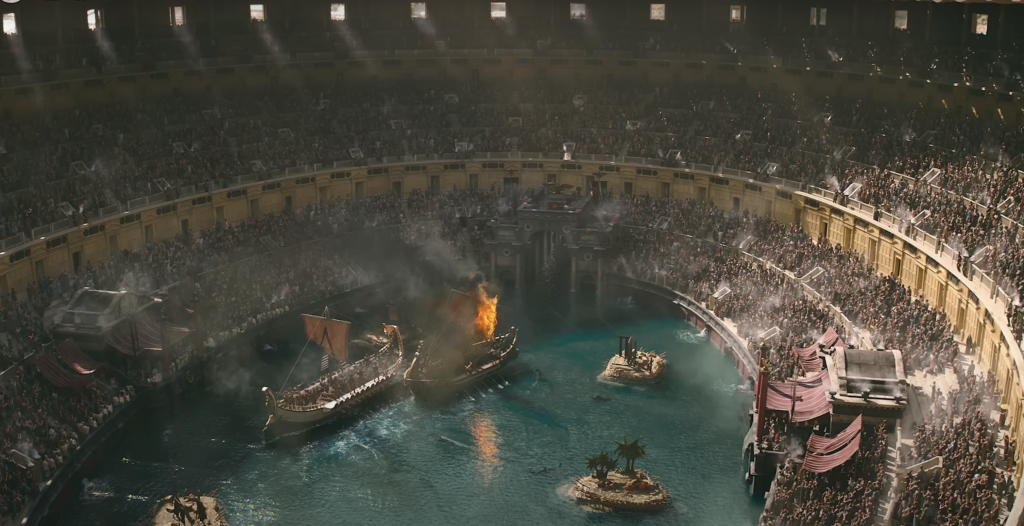
Colosseum Fact or Myth: Myth (probably)!
If you’ve watched Gladiator II, you’re probably wondering if the Romans actually flooded the Colosseum to create mock sea battles. Well, the answer is, hell yes they did. The Romans are famous for their love of entertainment—the bloodier the better, in their opinion. You probably already know that the Colosseum was used as an arena for gladiator fights, but that was actually just one of its many uses.
The Romans also used the Colosseum to host mock sea battles in what is referred to as naumachia. So, the depiction of a sea battle in Gladiator II was actually historically accurate in some ways. One thing the movie may have exaggerated is the shark.
Yes, it made for an epic movie scene, but archeologists haven’t found shark teeth or signs of sharks in the area, so there would be no reason to believe sharks were let loose inside the Colosseum. That said, given Romans loved setting wild and aggressive animals free during fights, it’s not off-brand to imagine a shark being let loose during mock naval battles.
14. Emperor Caracalla Was a Weak Man

Colosseum Fact or Myth: Myth!
The movie frequently depicts Caracalla as a sniveling, weak man. But in reality, he was anything but. To put it short, he started his reign by killing his brother and massacring his followers before waging multiple bloody battles (usually without justification).
He even massacred and plundered the City of Alexandria after discovering that someone performed a play mocking him. In short, Emperor Caracalla was unhinged, evil and anything but weak.
13. Lucius Versus II Lived Alongside Commodus
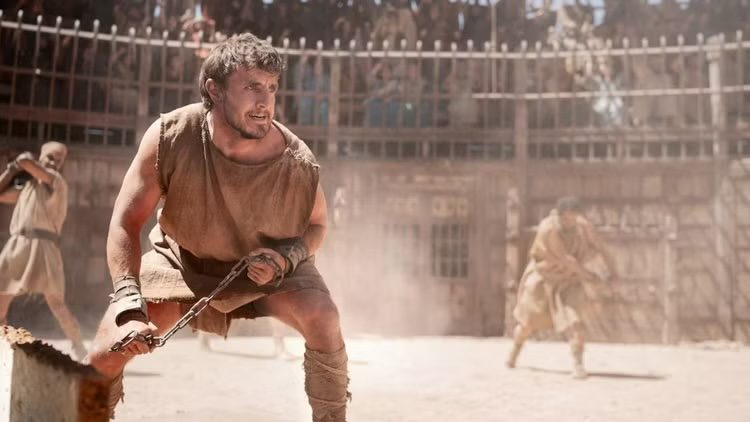
Colosseum Fact or Myth: Myth!
Gladiator II centers on the story of Lucius, but historically, the real Lucius Verus II died long before the events of the film. In fact, Lucius Verus II passed away at a young age, well before his uncle, Commodus, ascended to the Roman throne in 180 AD. Therefore, having Lucius as a character during Commodus’ reign has no basis in actual history.
We get it, you gotta take liberties to make a movie interesting. But if you want the real history behind Rome’s iconic Colosseum, you’re going to want the expert knowledge of a local historian. Check out our Colosseum tours to guarantee that you have all the most accurate (and insider) knowledge about the Rome’s Colosseum.
12. Gladiator Fights were to the Death
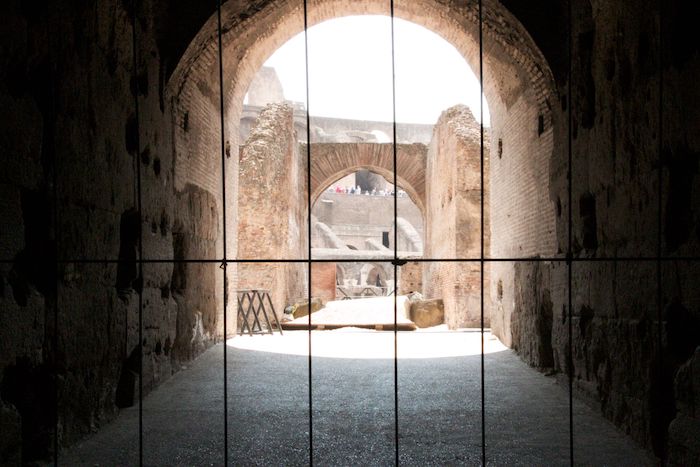
Colosseum Fact or Myth: Myth!
As bloody as gladiator fights undoubtedly were at times, they didn’t always end in death. Gladiator fights were a big business. Managers and promoters spent huge amounts of money training and publicizing their strongest men, and it’s bad for business if they allowed them to be killed off every week.
A gladiator could admit defeat by raising a finger, asking the referee to appeal to the editor to stop the fight. The final decision lay with the editor, who often listened to the crowd, typically bayed for blood, or if the fighter in question was particularly popular or longstanding, pleading for his life.
Whilst in the early years, death was the penalty for defeat, this changed as time went on. During the imperial period, it was common to have matches ‘sine missione’: where loss would not equal the death sentence. As the popularity of gladiator fights increased, however, the age-old principles of supply and demand kicked in. These fights were later banned by Emperor Augustus.
11. The Emperor Decided the Fate of Gladiators with a Thumbs up or Thumbs Down
Colosseum Fact or Myth: Fact, kind of.
This was invented by Jean-Léon Gérôm in his painting “Pollice Verso” which is Latin for thumb down. From there, Hollywood must have picked it up and ran with it. Unfortunately, the painter did not have access to the text of Juvenalis to fact check.
The emperor, with the help of the mob, often decided the fate of a gladiator and it is believed they would have used a hand gesture to display their decision but there is not much literature on the exactness of what happened except for this excerpt from Juvenalis’, “The Third Satire”
These men once were horn-blowers and attendants.
At every municipal arena, known as trumpeters in every village.
Now they present their own spectacles, and, to win applause,
Kill whoever the mob gives the “thumbs up.”
Thumbs up wasn’t even a sign of approval until the 20th century and not likely wide-spread until the Fonzie got a hold of it on Happy Days–and Fonzie is cool.
Juvenalis refers to the thumbs up being a sign for death and it is more likely that the thumb tucked into the Emperor’s palm signified the sword to be sheathed. That said, we are piecing together a heavily referred to gesture in today’s pop-culture by piecing together ancient text. It could have not been used at all!
10. Only Men Fought in the Colosseum
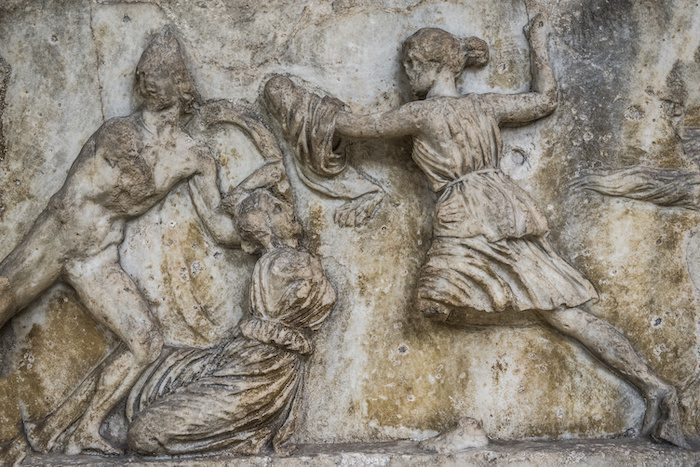
Colosseum Fact or Myth: Myth
As unusual as it might sound, there is evidence of women taking to the Arena Floor – a marble frieze from the second century depicts a legendary fight between two women, Amazon and Achillea. Perhaps the men felt threatened because female participation didn’t last long – in 200 A.D. the Emperor Septimius Severus banned women from the games.
9. Gladiator Fights Started in the Colosseum
Colosseum Fact or Myth: Myth
The first gladiators fought to the death at the funeral of a distinguished aristocrat Junius Brutus Pera in 264 B.C.. His relatives arranged the event to honor his death and provide a blood sacrifice for the gods. The Roman aristocracy thought this bloodthirsty battle gave the funeral a rather lovely sense of occasion, and the idea quickly caught on.
By 174 B.C., it was relatively commonplace to have matches across the city, and the idea was boosted further by Julius Caesar, who engaged hundreds of gladiators to fight in memory of his deceased father and daughter.
Popularity for the sport increased, and by the end of the first century B.C., government officials started holding public games. By the time the Colosseum opened in 80 A.D., gladiator fights had evolved from ad-hoc battles to a serious business.
8. Gladiator Fights Only Happened in the Colosseum
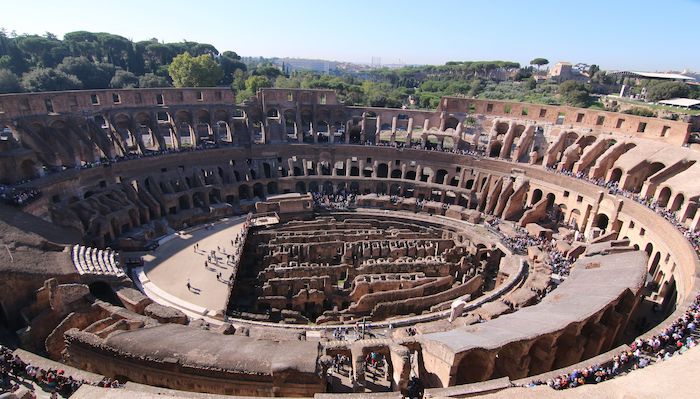
Colosseum Fact or Myth: Myth
Gladiator fights have become a defining feature of the Roman Empire, but they’re part of a tradition that actually began rather slowly – and well before the Colosseum was built. So, what were gladiator fights? In ancient Rome, gladiator fights occurred as a form of entertainment (like modern-day sports). Gladiators would fight to the death, sometimes accompanied by animals, to entertain the masses of Rome.
Just like anyone can throw a raging party on an island and say it was owned by Pablo Escobar, anyone could hold Gladiatorial events if they could find a venue. Pompeii was heavily known for fights and they had their very own stadium where Spartacus, the most famous of all Gladiators, called his home stadium.
7. Spartacus Fought in the Colosseum
Colosseum Fact or Myth: Myth
Spartacus died 99 years before the great Colosseum even broke ground.
6. Gladiators were Slaves
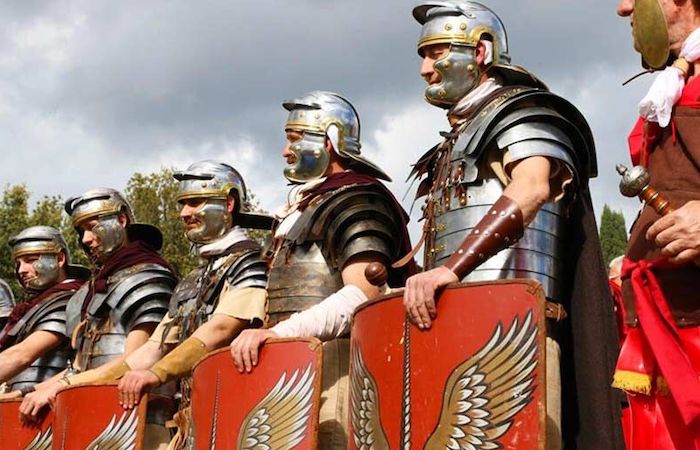
Colosseum Fact or Myth: Fact, 99% of the time.
Gladiators were mostly captive slaves until they were freed. It is very rare that a freed person would fight in the arena but a freed person could willingly accept slavery if they wanted to fight. It is unlikely they would do this because they wanted slavery. These types of circumstances were most likely due to large amounts of debt that these freed persons were unable to pay off. Joining a ludus and willingly becoming a slave could earn their families money.
The 1%
There is mention of times when an Emperor or Senator would disguise themselves and fight in the Colosseum. This would often be to impress their mate or mistress or simply for the thrill. These types of fights would almost always be rigged.
5. Commodus Fought in the Colosseum
Colosseum Fact or Myth: Fact!
Not only did Commodus fight in the Colosseum but he was possibly the most successful gladiator in history. The games were likely rigged but he could also afford the best training which would make him among the best.
4. Emperor Commodus Was Killed by Maximus in the Colosseum
Colosseum Fact or Myth: Myth, but not far from truth
As mentioned above, Commodus fought heavily in the Colosseum and was likely a great gladiator and worthy opponent to any. That said, he was out of his mind crazy and eventually assassinated. This would have happened on New Years Eve 192 AD. There would have been an attempt to poison him which went wrong followed by a physical assassination.
This is where there is so truth. While he did not die in the Colosseum he was killed by a wrestler named Narcissus who may have also been a gladiator at one time. He was the trainer to Commodus and likely took pleasure in the act.
Teachers – probably retired gladiators – taught their own specific techniques and methods but it was prohibited to train with real weapons, so to remind the students just how vicious their trade was, training also included preparation for a courageous, unflinching death.
There’s an idea that the fights were haphazard and lawless, but this is largely a myth – like many things in Roman times, they were actually highly organized. All gladiators, both volunteers and slaves, underwent extensive training at ‘gladiator school’ and were bound to service by a sacred oath.
3. Gladiatorial Games Happened Often
Colosseum Fact or Myth: Sometimes fact, sometimes myth.
Colosseum gladiator fights were as highly anticipated as the Superbowl or the World Cup final today. Gladiator games were advertised on billboards, publicizing the greatest gladiators of all time alongside other temptations – this could include live music, drinks, prizes, and even executions (in case the fights weren’t brutal enough).
Bloodthirsty though they may have been, the Romans were nothing if not dignified. Every event would begin with a procession of the referees and the editor. The person who organized and paid for the games, often the Emperor himself – walked in followed by fanfare and, finally, the bringing in of the ‘gods’ to witness the fight.
Fight could be organized for a series of days, weeks or even months during the inauguration of a new Emperor or on the coat tales of a great victory but it all cost money. On any given year, you would likely see less gladiator fights than home games from your favorite American NFL team.
2. Fights were Wild
Colosseum Fact or Myth: Myth, kind of.
After the fights started, it wasn’t the brutal free-for-all one might expect – trained gladiators were expected to follow professional rules of combat. Most matches had a senior referee and an assistant often retired gladiators whose judgment was, for the most part, final.
They could caution or separate opponents during the match, as well as pause games to allow the warriors to rest – or even stop them entirely. Most matches lasted between 10 and 15 minutes and were won by the gladiator who overcame or killed his opponent.
Popular Tours from Rome
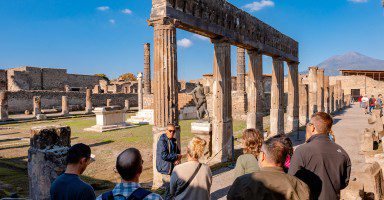
Best Seller
Unforgettable Rome Day Trip to Pompeii and Sorrento
Making a day trip from Rome to Pompeii and the Amalfi Coast can be daunting, with long travel times, complex routes, and tricky logistics to manage. Our full-day tour eliminates the stress, offering comfortbale transport straight to Pompeii. With an archaeologist guide, explore the ancient ruins without the hassle. Then, unwind with free time in Sorrento’s coastal charm. Led by a local guide and small group, this trip makes experiencing Italy’s highlights easy and enjoyable—all in one day.
See prices and more info

Best Seller
Rome in a Day Tour with Colosseum & Vatican Museums
Seeing the best of Rome in a single day might seem like a big undertaking, but our expertly designed tour makes it effortless with skip-the-line tickets, included transportation, and engaging guides to lead the way. In just 7 hours, you’ll visit renowned sites like the Sistine Chapel, Colosseum, Trevi Fountain, and Pantheon. With fascinating stories at every stop, you can skip the stress and immerse yourself in the vibrant heritage and culture of Rome all in one remarkable day.
See prices and more info
1. The Colosseum was Flooded for Naval Battles
Colosseum Fact or Myth: Fact
Yes, the Romans were able to flood the Colosseum although it may have only happened one time. Read more about Colosseum Naval Battles and Floods!
Here’s Where To Stay in Italy’s Most Popular Destinations
Rome, Florence, Venice, Amalfi Coast, and Capri
I Want More Italy!
- Check out our YouTube video and step-by-step guide about how to do Rome in a Day. If you’d rather let us guide you, check out our Rome tours.
- Not sure where to stay in Rome? Read this guide!
- Follow our adventures in Italy on Facebook, Instagram, and YouTube. Then, comment and tell us what you want us to cover next.
